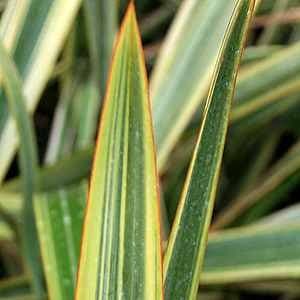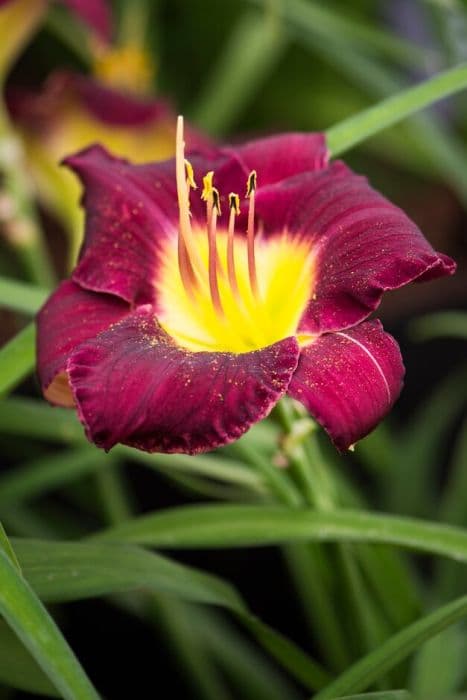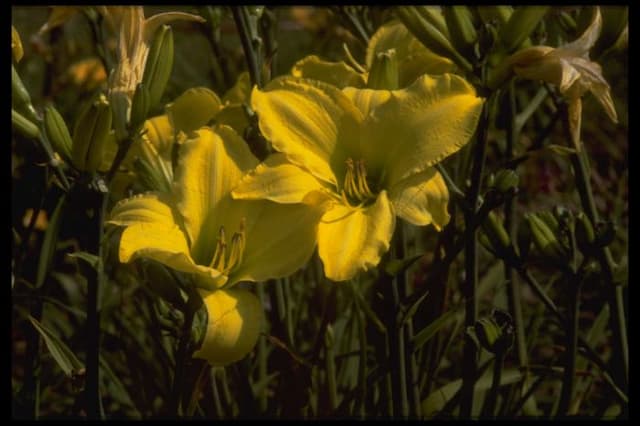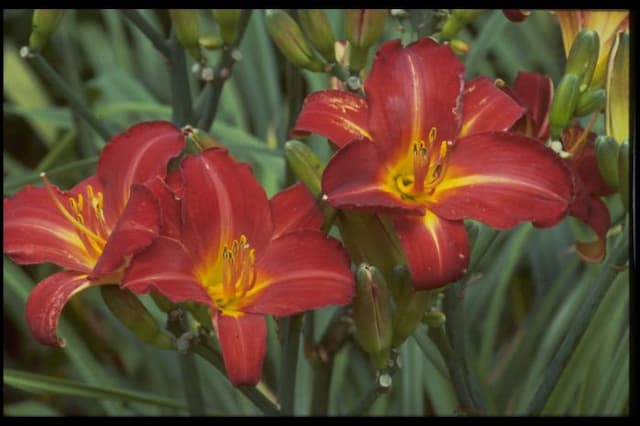New Zealand Flax Phormium cookianum 'Gold Ray' (v)

ABOUT
The 'Gold Ray' (v) New Zealand Flax is a striking perennial known for its dramatic foliage. The leaves are the most prominent feature, with a bold sword-like shape that arches gracefully. Each leaf offers a captivating striped pattern, mainly a rich green color adorned with creamy yellow stripes and a thin red or bronze edging which adds a contrasting touch to the leaf margins. The plant develops a clump-forming habit, with multiple leaves growing upward and outward from the base, creating a somewhat fountain-like effect. The texture of the leaves is coarse, contributing to the plant's visual interest throughout the year. In addition to the distinctive leaves, this New Zealand Flax can produce flower spikes that carry tubular flowers. These flowers can attract birds and add an additional element of height and contrast to the foliage. After flowering, seed pods may develop, which can persist on the plant, adding further interest even when the plant is not in bloom. Overall, 'Gold Ray' (v) New Zealand Flax is a bold and attractive plant that stands out in gardens and landscapes for its variegated foliage and strong form.
About this plant
 Names
NamesFamily
Asphodelaceae
Synonyms
New Zealand Flax, Mountain Flax, Wharariki
Common names
Phormium cookianum 'Gold Ray'
 Toxicity
ToxicityTo humans
New Zealand Flax is not generally considered toxic to humans. However, it might cause irritation or an allergic reaction in some individuals upon contact with the skin or if parts of the plant are ingested. It is not known to be a common cause of poisoning, and significant symptoms from ingestion are unlikely.
To pets
New Zealand Flax is similarly not generally recognized as toxic to pets. While not a common cause of poisoning, ingestion can potentially lead to mild gastrointestinal upset in some animals due to mechanical irritation rather than chemical toxicity. Signs could include vomiting or diarrhea if ingested in significant quantities.
 Characteristics
CharacteristicsLife cycle
Perennials
Foliage type
Evergreen
Color of leaves
Variegated
Height
4-5 feet (1.2-1.5 meters)
Spread
2-3 feet (0.6-0.9 meters)
Plant type
Shrub
Hardiness zones
8
Native area
New Zealand
Benefits
 General Benefits
General Benefits- Decorative Foliage: The variegated leaves of Phormium cookianum 'Gold Ray', commonly known as New Zealand Flax, add an aesthetic appeal to gardens and landscapes with their striking green and yellow stripes.
- Drought Resistance: Once established, New Zealand Flax is quite tolerant of drought, making it suitable for gardens in drier climates or where water conservation is important.
- Low Maintenance: This plant has relatively low maintenance needs, not often requiring pruning, fertilizing, or special care to thrive.
- Coastal Tolerance: New Zealand Flax is capable of growing in coastal areas, tolerating sea spray and salty conditions better than many other plants.
- Architectural Structure: Its upright, sword-shaped leaves provide an architectural element to garden design, offering both texture and form to the landscape.
- Erosion Control: The root system of Phormium cookianum 'Gold Ray' helps stabilize soil, making it useful for planting on slopes or in areas prone to erosion.
- Attracts Wildlife: The flowers of New Zealand Flax attract nectar-seeking birds like hummingbirds and can also be a food source for bees.
- Versatility: This plant can be used in a variety of garden settings, including borders, container plantings, and as a focal point in garden beds.
- Wind Resistance: New Zealand Flax can withstand windy conditions, which makes it ideal for exposed sites or coastal gardens where wind can damage more delicate plants.
 Medical Properties
Medical PropertiesThis plant is not used for medical purposes.
 Air-purifying Qualities
Air-purifying QualitiesThis plant is not specifically known for air purifying qualities.
 Other Uses
Other Uses- New Zealand Flax 'Gold Ray' fibers can be used in textile production, providing material for weaving traditional Maori cloaks called 'kakahu' and other handmade crafts.
- The plant's rigid leaves and fibrous texture make it suitable for creating garden structures like natural fencing or barriers, offering both functionality and aesthetic appeal.
- Because of its strong leaf structure, New Zealand Flax 'Gold Ray' can be incorporated into floral arrangements to add a striking vertical element with a splash of color.
- The plant can serve as a natural mulch as its leaves, when fallen or trimmed, can be layered across the soil to retain moisture and suppress weeds.
- Leaves from the New Zealand Flax 'Gold Ray' can be used in basketry to create decorative and functional handmade baskets.
- The durable leaves can be twisted or braided into ropes and cords, providing material for rudimentary garden ties or craft projects.
- New Zealand Flax 'Gold Ray' provides a habitat and food source for various species of birds, serving as an ecological addition to a garden.
- The plant's tall, upright habit and colorful variegation can be used in landscape design to create focal points or to delineate spaces within the garden.
- The pollen and nectar of the New Zealand Flax 'Gold Ray' can attract bees and butterflies, making it a beneficial choice for pollinator-friendly gardens.
- When planted in groups or clusters, New Zealand Flax 'Gold Ray' can act as a windbreak, reducing wind speed and providing shelter in exposed garden areas.
Interesting Facts
 Feng Shui
Feng ShuiNew Zealand Flax is not used in Feng Shui practice.
 Zodiac Sign Compitability
Zodiac Sign CompitabilityNew Zealand Flax is not used in astrology practice.
 Plant Symbolism
Plant Symbolism- Resilience: The hardy nature of New Zealand Flax means it's often associated with resilience and the ability to withstand tough conditions.
- Resourcefulness: Traditional uses of New Zealand Flax by Māori for weaving and medicinal purposes symbolize resourcefulness and versatility.
- Beauty and Elegance: The 'Gold Ray' variety, with its striking variegated leaves, symbolizes beauty and elegance in the garden.
- Prosperity: In some cultures, the vibrant growth and lush foliage of the New Zealand Flax may symbolize prosperity and growth.
 Water
WaterNew Zealand Flax prefers consistent moisture, but it does not like to be waterlogged. During the active growing season in spring and summer, water the plant thoroughly once a week, allowing the top inch of soil to dry out between waterings. Reduce the frequency of watering to every other week in the fall and winter when the plant's growth slows down. On average, use about 1 gallon of water for each watering session depending on the size of your New Zealand Flax and the dryness of the soil. Adjust the amount based on rainfall and extreme temperatures, as both can affect how much supplemental water the plant needs.
 Light
LightNew Zealand Flax thrives in full sun to partial shade. It prefers a spot where it can receive at least six hours of direct sunlight daily, but it can also tolerate some light shade, especially in hot climates. Avoid deep shade, as this can reduce the vibrancy of the plant's foliage and overall health.
 Temperature
TemperatureNew Zealand Flax can tolerate a wide range of temperatures but thrives in conditions between 65°F and 75°F. It can withstand minimum temperatures down to about 15°F, but frost and prolonged cold can damage the foliage. Ideal conditions for New Zealand Flax would prevent exposure to temperatures consistently below 50°F or above 90°F.
 Pruning
PruningPrune New Zealand Flax to remove dead or damaged leaves and to maintain its shape. Pruning can be done in late winter or early spring before new growth begins. This plant does not require frequent pruning, but periodic removal of old, unsightly foliage keeps the plant looking its best. Additionally, cutting back flower stalks after they've bloomed will encourage a tidier appearance.
 Cleaning
CleaningAs needed
 Soil
SoilNew Zealand Flax thrives in a well-draining soil mix with good aeration, consisting of a combination of loam, peat, and sand. It prefers a slightly acidic to neutral pH, between 5.5 and 7.5.
 Repotting
RepottingNew Zealand Flax doesn't require frequent repotting; it should be repotted every 2-3 years or when it outgrows its current pot.
 Humidity & Misting
Humidity & MistingNew Zealand Flax prefers moderate humidity levels but is quite adaptable and can tolerate a range of humidity conditions in typical home environments.
 Suitable locations
Suitable locationsIndoor
Place New Zealand Flax in bright, indirect light and maintain moderate humidity.
Outdoor
Plant New Zealand Flax in full sun to part shade in a sheltered spot.
Hardiness zone
8-11 USDA
 Life cycle
Life cycleNew Zealand Flax 'Gold Ray' begins its life cycle as a seed, which, once germinated, grows into a small seedling. This growth stage is characterized by the emergence of initial roots and shoots. As the plant matures, it enters the vegetative stage, developing long, sword-like leaves with distinctive yellow and green variegation, and a robust root system. Eventually, the plant reaches the reproductive stage, where it produces flower spikes that can be up to several meters in height, bearing tubular flowers that attract birds and insects for pollination. After successful pollination, seed capsules form and, once mature, release seeds, completing the cycle. Throughout its life, the New Zealand Flax 'Gold Ray' can also propagate vegetatively through the division of its rhizomes, creating new genetically identical plants.
 Propogation
PropogationPropogation time
Spring-Early Summer
Propogation: New Zealand Flax 'Gold Ray' is typically propagated through division, a method most successful when performed in the spring as the plants emerge from winter dormancy. To propagate by division, carefully dig up the clump of New Zealand Flax, taking care to maintain as much of the root system as possible. Using a sharp spade or knife, slice through the clump to separate it into smaller sections, ensuring that each new section has a portion of the roots and several growing points or fans of leaves. These sections can then be transplanted into prepared holes that are twice the width of the roots, setting the plants at the same depth they were growing at previously. Water the new divisions thoroughly after planting to help establish them.









